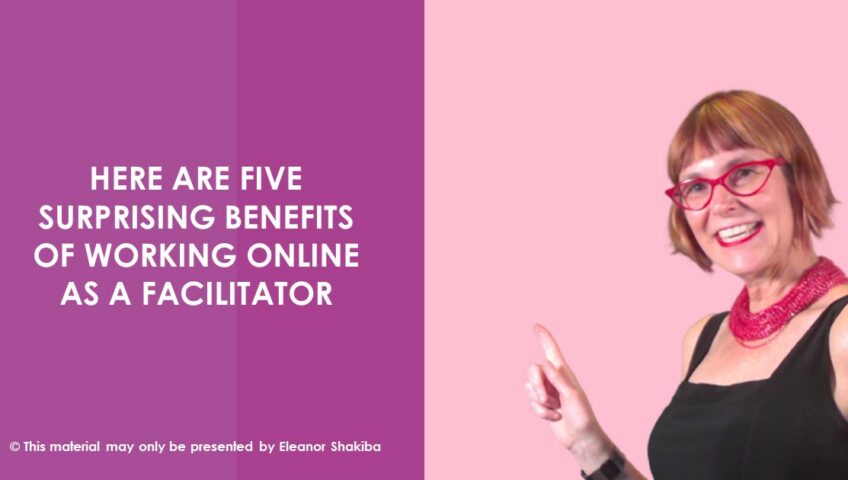Presenting online training is tricky. Indeed, before Covid 19 forced me into the online space, big time, I believed Zoom training was a poor second to face-to-face. 2020 proved me wrong. It taught me that masterful facilitation leads to deep learning, regardless of the delivery medium.
If you’ve been disappointed or exhausted by an online program, don’t blame Zoom. Blame the facilitator. There is a real knack to keeping engagement and energy levels high online. Trainers who specialise in experiential and group work techniques seem to have an advantage over those grounded in pure presentation skills.
I’ve been very pleasantly surprised by the versatility online training can provide. During my unexpected foray into online delivery, I’ve learned that small group, online sessions can very productive. Even more so than learning events delivered classroom style. Here are five surprising benefits of working online as a facilitator.
Breakout rooms are great for small groups to work in
Zoom breakout spaces are far less hectic than on-site breakouts. Provided that participants manage background noise, Zoom spaces create a more intimate and easier to manage dynamic than poorly designed training rooms. The biggest advantage Zoom has over a physical classroom is that it enables small groups to work in a far more confidential manner. More than is possible in a live training environment involving a single space with small work groups spread around it. I confess, this is my favourite discovery about working online.
Trainers are forced to be more disciplined about briefing
Whoever designed Zoom breakout spaces didn’t factor in a trainer’s need to display slideshows in breakout spaces. This forces facilitators to create separate briefing documents for all their group activities. An unexpected benefit of this, is that groups stay on focus far more effectively than when they’re working from a slide displayed at the front of the training room. During 2020, I discovered that exactly the same exercises I use face-to-face work equally well once briefing documents are converted to fit the online environment.
Names are easier for everyone to read
Name tags and place cards have their limits. As they get older, for example, many people cannot read a name tag across the room. Working online enables us to all have our names clearly displayed at all times. This subtly influences group dynamics, because it allows people with poor memories to refer to their co-learners by name. Several participants in my online programs have commented on how much difference this single aspect of Zoom delivery makes for their comfort levels.
Learner personalities are often easier to read in virtual environments
You’ve probably noticed how you get a different sense of someone when you can see their home environment behind them. Even if a learner is using a virtual background, this still creates an interesting frame for their personality. Facilitators can capitalise on this peak into people’s individuality by subtly making use of learners’ own environments during training programs.
Distant peers become closer during online delivery
The most exciting part of my 2020 online experience was delivering a sustainability program. This involved participants Zooming in from Africa, the Middle East, Europe and Asia. The group was small enough to enable us all to have our cameras switched on, rather than working in webinar mode. This made participants’ experiences far more real as people told their stories. The Zoom environment provided us all with a fascinating glimpse into others’ cultures and working environments. The end result was a more connected and stronger learning environment.
So who would have thought I’d be singing the praises of online delivery? Certainly not me 12 months ago. I’m grateful to the COVID-19 19 pandemic for giving me a reason to explore ways to translate effective facilitation into the online environment. After all, now I’m in this space, it will be easier to reach my goal of bringing positive psychology to 100,000 people around the world.
If you’d like to find out more about how to be an expert facilitator, not just a presenter, download my Positive Psychology Toolkit for HR and L&D Practitioners now.
About the author: Eleanor Shakiba
Eleanor is a trainer and coach, with a passion for unleashing the power of positive deviance in talented people. She has taught more than 50,000 people how to excel professionally. An expert in the field of Positive Psychology, Eleanor is also qualified in Social Anthropology, Counselling, Coaching, Adult Education and Neuro Linguistic Programming. She specialises in helping HR and L&D practitioners to unleash the power of positive psychology in business. Her major focus in developing three key areas that support positive workplace cultures: positive mindset, proactive communication and purposeful leadership. Eleanor is the author of the Positive Psychology Toolkit for HR and L&D Practitioners. Download your free copy here.
